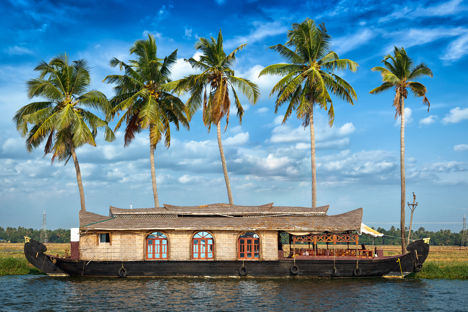
A journey to Kerala with Peter Joseph
Tamarind head chef Peter Joseph might have been in the UK for ten years, but he remains closely tethered to his south Indian roots – particularly the state of Kerala. We caught up with him to learn more about the region and its unique gastronomic virtues.
A journey to Kerala with Peter Joseph
Tamarind head chef Peter Joseph might have been in the UK for ten years, but he remains closely tethered to his south Indian roots – particularly the state of Kerala. We caught up with him to learn more about the region and its unique gastronomic virtues.
View more from this series:
Regions of IndiaGiven the moniker of ‘God’s Own Country’, Kerala is regarded as one of the most idyllic locations on earth. Cleaner and less chaotic than some other areas of India, the region has one of the highest literacy rates in the country – in 1989 Kottayam, a city in central Kerala, became the first in India to achieve one hundred percent literacy.
Overall, the state is probably most appreciated for the stunning diversity of its landscape. Eastern fringes take in the Western Ghats – lush highlands of wild flowers and wilder animals – while on the western side you can find a lengthy stretch of the Malabar Coast, with its wealth of picture-perfect beaches. Labyrinthine networks of waterways loosely connect the two flanks. On these backwaters you will find the distinctive Ketuvallams, traditional houseboats constructed from coir knots which were once used to transport rice across the region and can now be rented out by tourists.
Chef Peter Joseph remembers the Ketuvallams fondly from his time in Kerala. ‘The boathouses on the backwaters – with the nice bedrooms, balcony, everything on one boat – do more than just take you from one place to another; you can see all the different places, the scenery,’ he says. ‘It’s amazing and beautiful.’
If a Ketuvallam trip represents an ideal way to see Kerala, then Peter argues it is also a great way to taste Kerala, too. Among the paddy fields and coconut tree-lined lagoons are some quirky local masala cafes serving traditional Keralan dishes such as Karrimeen (grilled fish).
Fish and seafood are abundant here and help distinguish Keralan food from other regions in India, where vegetarian ingredients tend to dominate. ‘We primarily do north Indian cuisine at Tamarind,’ Peter says, ‘but when it comes to Indian seafood there is not much in northern India in terms of sauces. We have a Malabar prawn dish at Tamarind, while for Tali Macchi (grilled sea bass) we use the base sauce from Kerala – tomato and tamarind.
‘I love the cuisine there,’ he continues. ‘Overall, Keralan food is quite healthy, with lots of coconut and peppercorns for flavour. In the north of the state, there are more peppercorns and chilli. South Kerala has milder flavours.’
Different strokes
This north-south divide in Keralan culture can be traced back millennia. Southern areas of Kerala take cultural influence from early Christian Syrian settlers, as well as Chinese, British, Dutch and Portugese traders, who used cities like Kochi for spice trading. Here you will find fragrant, creamy stews with strong coconut flavours. Head further north, however, and there is a greater emphasis on spice, meat and Arabic flavours, with the so-called Malabar cuisine dominant. Thalassery biryani is a popular preparation here, and involves slow-cooking meat in masala spices, topping with kaima rice (a thinner variety) and sealing with a dough lid.
Spices remain the lingua franca of Keralan life and are used distinctively, often to add tang and fragrance rather than pure heat. Peter considers ginger, cardamom, asafoetida, chilli, tamarind and peppercorn to be the most important – most of which are produced locally before being sold on the streets of every village and town. ‘I love the atmosphere created by the shops when they open early in the morning – the smell of camphor, sandalwood and incense sticks,’ he explains. ‘It has a calming effect on the senses.’
Coconuts, which grow everywhere in Kerala, are another mainstay; their milk is used for sauces and their oil for frying off meat, fish and vegetables. The sap of the palm tree is also used, most notably to create an alcoholic drink known as Toddy.
Recipes for success
The resources are perfect and over centuries the locals have developed delicious ways to make the most of what they have. ‘Recipes are passed down from mother to daughter,’ Peter explains, ‘so none of Kerala’s traditional dishes are lost.’ The role played by women in preserving and maintaining Kerala’s rich traditions is of the utmost importance. After all, this is a region with a packed calendar of festivities, and no Keralan occasion is complete without a feast of traditional dishes. Onam, a secular event that takes place around August and September each year, features a series of vegetarian dishes presented on plantain leaves (Sadhya), which are common in Kerala. During Pongola, women line the streets in their millions bearing earthenware pots of rice, jaggery and coconut, which they will take to the temple and offer to the gods in a show of ceremony.
Kerala provides an endless source of fascination for Peter, and from his evocative descriptions of his time there it is easy to see why. The unique blend of cultures, the diverse food scene and a sumptuous landscape add up to a recipe the chef looks destined to return to again and again. ‘I always love to go back to Kerala,’ he says. It could be for anything – holiday, research, meeting friends – but mostly to enjoy the natural features of the landscape as well as the distinguished cuisine.’

